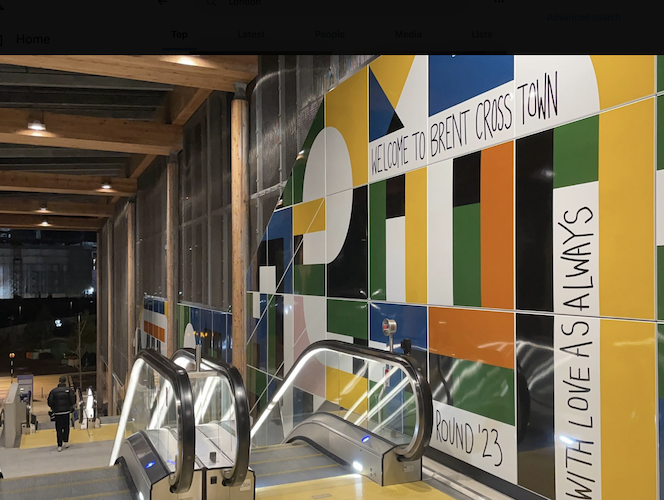Long ago, in a previous life, when I owned a motor vehicle, I would quite often visit the Brent Cross Shopping Centre. It was described in those times as the country’s first ever out-of-town, US-style mall – a “futuristic concept” according to a local paper, a “veritable perfumed nirvana” in the teasing words of New Society magazine.
The centre opened in 1976 and still had a box-fresh feel back when I wandered its indoor avenues. My strongest memory of it, though, is of endlessly circling its packed, sprawling car parks, tensed to pounce on any space set to become available. This stressful ritual would come at the end of a long haul round the North Circular. The shopping part was fine – me, I quite like a retail cathedral – but getting to that stage was an ordeal.
Today’s opening of the new Brent Cross West railway station, Sadiq Khan presiding (see below), will not do all that much to take the motoring strain out of the consumer experience, because it is a 20-minute walk away – not ideal if you’ve bought a set of crockery or a vacuum cleaner, or are laden with half-a-dozen carriers. Even so, the new station and the wider plans for the area it has been built to serve demonstrate how London and ideas about how to make a modern city work well have changed since 50 years ago.

The station itself is quite a feat of engineering. Ian Mansfield, who paid it a prior visit, has summed it up as “a four-platform station that sits above the main railway line, with a large covered footbridge linking both sides of the railway for the first time in 150 years”. As Ian adds, building it has not been easy because it had to be assembled above lines that were already in frequent use. Ian likes the look of it, calling it an “impressive” far cry from the much more basic additions to London’s rail network of late. City Hall is billing it as the first mainline station to open in London for over a decade.
Brent Cross West, sitting between Cricklewood and Hendon stations, will be served by Thameslink trains running to and from St Pancras 12 minutes away. And its longer-term purpose is to anchor and nurture the development of a new piece of London – Brent Cross Town, a 6,700-home settlement, complete with 50 acres of parks and playing fields and three million square metres of office space, already putting down roots between the shopping centre and the new station.
A joint venture between Barnet Council, which owns the shopping centre freehold and much of the land south of the North Circular, and developer Related Argent, its sales pitch evokes a quite different ideal tomorrow from that which the shopping centre typified. Described by Barnet as “a new park town” at the heart of the wider Brent Cross Cricklewood regeneration programme, it makes a virtue of its proximity to central London rather than being an “out-of-town” distance from it, and talks up its net zero carbon, green and “wellness” credentials. Bus, train and bicycle transport receive higher prominence than roads, even though the M1, as well as the North Circular, is close by.
The story of the station and of the growth of Brent Cross in general since the mid-1970s has involved many politicians going back to well before Mayor Khan was first elected in 2016 or Labour won control of Barnet Council last year. There have been some false starts. In 2003, the Labour national government blocked a planning permission granted by the then Conservative-run Barnet for an extension to the shopping centre because it relied too heavily on customers arriving by car. Labour also impeded an application passed by Tory Barnet in 2009, which included the “new town”. But Mayor Khan’s predecessor, Boris Johnson, favoured it and, after some changes were made, the Conservative-Liberal Democrat coalition government elected in 2010 waved it through without a public inquiry.
Then, in 2014, the scheme was split in two. The following year Related Argent came on board with the council to build the section to the south of both the North Circular and the shopping centre. In 2016, the government stumped up £97 million towards the cost of the new railway station, essential to making the completed development both more functional and more attractive. In the end, the government contributed the full £419 million cost and Barnet has completed the project.
What will happen next? Homes are already under construction. Having largely been moulded by Conservatives, the next stages of Brent Cross Cricklewood look likely to be increasingly in Labour hands. There are hopes that Brent Cross West will eventually form part of a west London orbital Overground rail link with Hounslow. Slowly, often reluctantly and sometimes bitterly, the age of the car may be giving way to a new age of the train.
X/Twitter: On London and Dave Hill. Threads: DaveHillOnLondon. Photo of Sadiq Khan and colleagues by Caroline Teo for the Greater London Authority. If you value On London and its coverage of the capital, become a supporter or a paying subscriber to Dave Hill’s personal Substack for just £5 a month or £50 a year. In return, you’ll get a big, weekly London newsletter and offers of free tickets to top London events.

